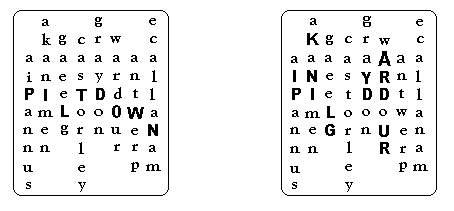Kipling as Cryptographer: the Piltdown Caper
by Stephen A. Blossom
A vengeful hoax with old bones perpetrated in 1912 confounded many British
scientists when it was exposed four decades later, and the idea that
Rudyard Kipling knew about it all along was debated in literary circles,
although it was never accepted as an established fact, in spite of
questions raised by a story he wrote.
Now, however, research has found two hidden references in the story itself
that reveal a connection between the hoax and the story.
Kipling’s story, “Dayspring Mishandled”, published in 1928, tells the tale
of an elaborate literary hoax involving Chaucer; no connection with
Piltdown was then apparent because the fakery with the fossils had not yet
been discovered. After the trickery was unmasked, speculation regarding
Kipling was based principally on the striking parallel between details of
the hoax at Piltdown and the hoax in the story. In each case the work
done was almost incredibly abstruse, requiring much scholarly attention to
the fine points, and clever, careful planning so that the victim never
discovered the deception.
Two recent pieces of internal evidence from “Dayspring” seem to have been
created by the author specifically to show a direct linkage to the
scientific deception. One is a quotation, the other an acrostic puzzle
concealed in names from the story.
The clue of the quotation needs only slight exposition. The Piltdown
discoveries were officially presented to the world in London on December
12, 1912, at a meeting of the Geological Society. The “fossils” were
represented by a plaster reconstruction of the skull based on a few skull
bones, teeth and part of a jaw. The originals were presumably in
safekeeping.
Sir Arthur Keith, president of the Royal Anthropological Institute, one of
several speakers, proclaimed that the discovery had fulfilled the prophecy
of what the ancestor of man was likely to be. Another speaker, W. L.
Duckworth, repeated this thought: “The anatomy of the Piltdown skull
realized largely the anticipation of students of evolution”, he said.
Kipling uses the same idea. A convincing hoax has taken in Castorley, the
story’s villain, but his wife has guessed the truth. The dying Castorley
is quoting his wife: “… that the Chaucer find had anticipated the
wants of humanity …”.
This correlation might be dismissed as mere coincidence if it were not for
the interlocking names in the acrostic, a correlation that goes beyond
coincidence.
Eight names from the story form the basis of this cryptic text:
Manallace (the protagonist)
Castorley (see above)
Graydon (the operator of an editorial syndicate)
Gleeag (a physician)
Wardour Street (the address of certain publishers)
Neminaka’s Cafe (a literary meeting place)
Antwerp (home of a copier of Chaucer manuscripts)
Sunnapia Collection (A buyer of old manuscripts).

This is the kind of cipher that Manallace used to conceal his signature in
the story. When we align the names so that the letter A appears eight
times in a row, as above, we can pick out the secret signature and the
real topic of the story. The names of the hoaxers, however, are not
revealed, although Kipling certainly must have known them.
It has been suggested that “Dayspring” is a mature version of
Kipling’s earlier “Stalky & Co.” and it is hard to argue with that.
He must have been thinking of his youth when he selected the verse by
Nodier to put at the head of the story. In rough translation from the
French, it reads “The child of the good old days, I wake at dawn and
sing for you.” The Stalky days, his youth, were filled with pranks.
A fact that should be noted is that Kipling’s home was less than 20
miles from the Piltdown site. The attraction of the “digs” must have
been almost irresistible because his journalistic instincts were
deeply ingrained.
His keen personal interest in intelligence operations is evident in
“Kim” and the Stalky stories.
Also, we should note that the scientific name given the Piltdown man
was “Eoanthropus dawsoni, or “Dawn man of Dawson.” Joseph Weiner, a
member of the team investigating the bones, must have been one of the
first to suspect a touch of Kipling. He noted in a letter that
“Dayspring” was a poetical term for dawn, and he wondered how Kipling
had arrived at the title of the story.
The contention here is that we have two strong new (although
circumstantial) links between “Dayspring” and Piltdown, namely the
crossword puzzle arrangement and the quotation. In combination with
the arguments already set forth they should come close to clinching
the matter. The author must have had private intelligence regarding
Piltdown, and the fiction is intimately connected with the fact.
SOURCES
“The Piltdown Men” by Ronald Millar, 1972
“Piltdown, a Scientific Forgery” by Frank Sherman 1990
The Piltdown Papers” by Frank Sherman 1990
NOTE: Some readers may dismiss this article as the product of a wild
imagination, but a careful reading of the story will show that each
place name and personal name in the acrostic diagram can be found in
Kipling’s text, without any spelling variations. Other readers might
view the diagram as a mere random coincidence, a happenstance. An
analysis of the probability of such an occurrence, however, would put
the odds against it at many billions to one. A person experienced in
the design of crossword puzzles, of course, could easily design such
an arrangement on purpose. The question is whether Kipling did it on
purpose or by happenstance.
This page was last updated August 27, 2000.
Copyright © 1999 by Stephen A. Blossom
